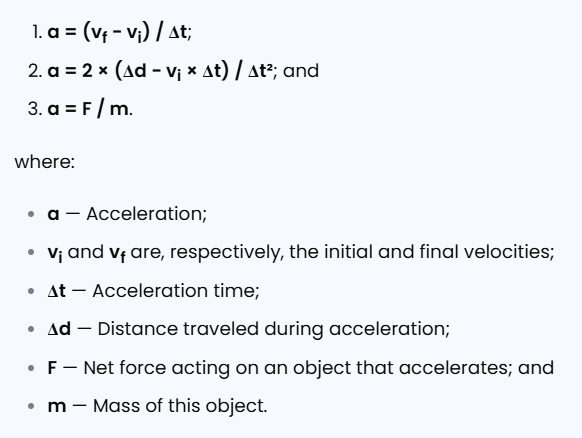 Home
Home
 Back
Back

Definition: This calculator computes the acceleration of an object using one of three methods: Speed Difference, Distance Traveled, or Mass and Force, based on fundamental physics principles. Acceleration is the rate of change of velocity per unit time.
Purpose: It is used in physics, engineering, and automotive applications to analyze motion, optimize vehicle performance, design structures, and conduct experiments. The calculator supports independent unit selection for each input, inspired by tools like Omni Calculator’s Acceleration Calculator.
The calculator supports three methods to compute acceleration, each with a specific formula. Time inputs for Speed Difference and Distance Traveled, and mass for Mass and Force, must be positive to ensure valid calculations:
Unit Conversions:
Details: Calculating acceleration is crucial for analyzing vehicle performance, designing engineering systems, conducting physics experiments, and evaluating motion in sports science.
Tips: Select the calculation method, enter the required inputs with their units (e.g., velocities in m/s or mph, time in s, mass in kg), ensuring time and mass are positive. Click “Calculate” to get the acceleration in m/s², ft/s², and g. The result uses scientific notation for very small (< 0.0001) or large (> 10,000) values.
Given (Speed Difference - Car): Initial Velocity = 0 km/h, Final Velocity = 62 mph, Time = 5 s.
Calculation: Convert units: \( v_i = 0 \, \text{km/h} = 0 \, \text{m/s} \), \( v_f = 62 \times 0.44704 = 27.7165 \, \text{m/s} \), \( \Delta t = 5 \, \text{s} \).
- \( a = \frac{27.7165 - 0}{5} \approx 5.5433 \, \text{m/s}^2 \)
- In ft/s²: \( a = 5.5433 \times 0.3048 \approx 1.6896 \, \text{ft/s}^2 \)
- In g: \( a = 5.5433 \times \frac{1}{9.80665} \approx 0.5651 \, \text{g} \)
Result (within 0.0001–10,000): 5.543 m/s², 1.690 ft/s², 0.565 g.